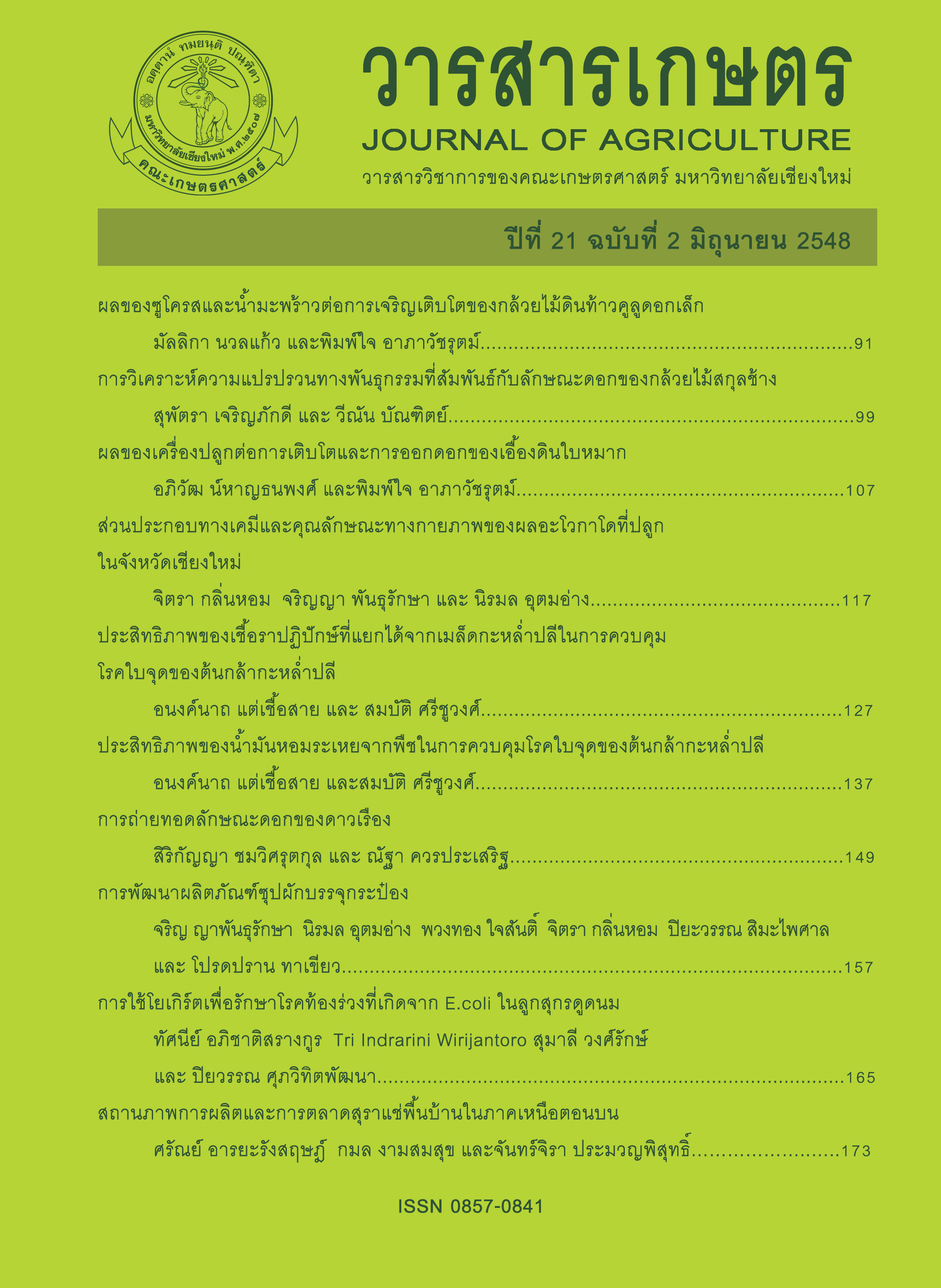ส่วนประกอบทางเคมีและคุณลักษณะทางกายภาพของผลอะโวกาโดที่ปลูกในจังหวัดเชียงใหม่
Main Article Content
บทคัดย่อ
ผลการศึกษาส่วนประกอบทางเคมีและลักษณะทางกายภาพของผลอะโวกาโด 4 สายพันธุ์ (ปีเตอร์สัน บูช 8 บัคคาเนีย และแฮส) พบว่าพันธุ์แฮสมีระดับไขมันในผลสูงที่สุด ผลการวิเคราะห์ปริมาณกรดไขมันในผลอะโวกาโดโดยใช้ gas chromatography พบว่ากรดไขมันในผลอะโวกาโดทุกสายพันธุ์ส่วนใหญ่เป็นกรดโอเลอิค รองลงมาคือ กรดปาล์มมิติคและลิโนเลอิค ตามลำดับ อัตราส่วนของกรดไขมันชนิดไม่อิ่มตัวต่อกรดไขมันชนิดอิ่มตัว พบว่า มีค่าแคบกว่าที่ได้เคยมีการรายงานไว้ สาเหตุอาจเกิดเนื่องมาจากความแตกต่างของสภาพภูมิประเทศและภูมิอากาศ ที่ปลูกอะโวกาโด ผลอะโวกาโดพันธุ์แฮส มีระยะเวลาในการสุกช้ากว่าสายพันธุ์อื่น ซึ่งอาจเป็นเพราะสายพันธุ์นี้มีระดับแร่ธาตุสูง สายพันธุ์บูช 8 และบัคคาเนีย มีขนาดผลใหญ่ แต่มีระดับคาร์โบไฮเดรตต่ำ และไม่พบว่าทั้ง 4 สายพันธุ์ มีความแตกต่างกันในระดับของเยื่อใย ความแน่นเนื้อของผลอะโวกาโดขึ้นอยู่กับปริมาณน้ำและไขมัน ผลอะโวกาโดที่มีปริมาณน้ำสูงจะทำให้ความแน่นเนื้อสูงตามไปด้วย ในขณะที่การเพิ่มขึ้นของปริมาณไขมันทำให้ความแน่นเนื้อลดลง คุณภาพสีของเนื้ออะโวกาโดพันธุ์ปีเตอร์สัน มีสีเข้มกว่าทุกสายพันธุ์ และไม่พบว่า L value (ความสว่าง) นี้มีความเกี่ยวข้องกับส่วนประกอบทางเคมี อย่างไรก็ตาม พบว่าปริมาณไขมัน และความชื้นมีผลต่อ a value (สีเขียว)
Article Details
References
งานไม้ผล มูลนิธิโครงการหลวง. 2540. อะโวกาโดและการขยายพันธุ์. เอกสารประกอบการฝึกอบรม. ตุลาคม 2540. , มูลนิธิโครงการหลวง, เชียงใหม่.
พันทิพา สุทราชุน. 2528. ความรู้เบื้องต้นเกี่ยวกับการวางแผนงานทดลอง. รุ่งศิลป์การพิมพ์, กรุงเทพฯ. 352 หน้า.
ฝ่ายวิชาการ สถานีทดลองพืชสวนดอยมูเซอ. 2539. การปลูกอะโวกาโด. สถานีทดลองวิจัยพืชสวนดอยมูเซอ,กรมวิชาการเกษตร, กรุงเทพฯ. 37 หน้า.
AOAC. 1998. Official Methods of Analysis.16th ed./Rev.4. Association of Official Analytical Chemists International. Maryland.
Ahmed, E.M. and C.R. Barmore, 1980. Avocado. pp. 121-165. In: S. Nagy and P.E. Shaw,(eds.). Tropical and Subtropical Fruits, Composition, Properties and Uses. AVI Publishing Co., Westport, Ct.
Biale, J.B. and R.E. Young, 1971. The avocado pear. pp. 2-60. In: A.C. Hulme, (ed.). The Biochemistry of Fruits and Their Products. Academic Press, New York.
Chichester, C.O. and R. McFeeters, 1971. Pigment degeneration during processing and storage. pp. 707-717. In: A.C. Hulme, (ed.). The Biochemistry of Fruits and Their Products. Academic Press, New York.
Cohen, E. 1988. The chemical composition and sensory flavour quality of “Mineola” tangerines. I. Effects of fruit size and within-tree position. J. Hort. Sci. 63: 175-178.
Cutting, J.G.M. and B.N. Wolstenholme, 1992. Maturity and water loss effects on avocado (Persea americana Mill.) postharvest physiology in cool environments. J. Hort. Sci. 67: 569-575.
Eaks, I.L. 1985. Effect of calcium on ripening, respiratory rate, ethylene production and quality of avocado fruit. J. Amer. Soc. Hort. Sci. 110: 145-148.
Enser, M., K.G. Hallett, B. Hewett, G.A.J. Fursey, J.D. Wood and G. Harrington. 1998. Fatty acid content and composition of UK beef and lamb muscle in relation to production system and implications for human nutrition. Meat Sci. 49: 321-334.
IUPAC. 1987. Standard Methods for the Analysis of Oils, Fats and Derivatives. 7th ed. Applied Chemmisty Division, Commission on Oils, Fats, and Derivatives, Blackwell Scientific Publications, Oxford.
Lewis, C.E., R. Morris and K. O’ Brien. 1978. The oil content of avocado mesocarp. J. Sci. Food Agric. 29: 943-949.
Ratovohery, J.V., Y.F. Lozano and E.M. Gaydou. 1988. Fruit development effect on fatty acid composition of Persea americana fruit mesocarp. J. Agric. Food Chem. 36: 287-293.
Seymour, G.B. and G.A. Tucher. 1993. Avocado. pp. 53-81. In: G.B. Seymour, J.E. Taylor and G.A. Tucher, (eds.). Biochemistry of Fruit Ripening. Chapman and Hall, London.
Swart, D.H. 1978. Microwaves used in determining avocado maturity. Citrus Sub-Trop. Fruit J. 535: 3-5.
Tucher, G.A. 1993. Introduction. pp. 1-51. In: G.B. Seymour, J.E. Taylor and G.A. Tucher, (eds.). Biochemistry of Fruit Ripening. Chapman and Hall, London.

